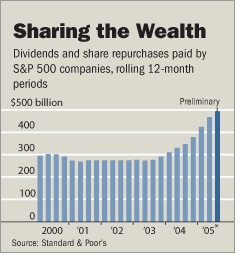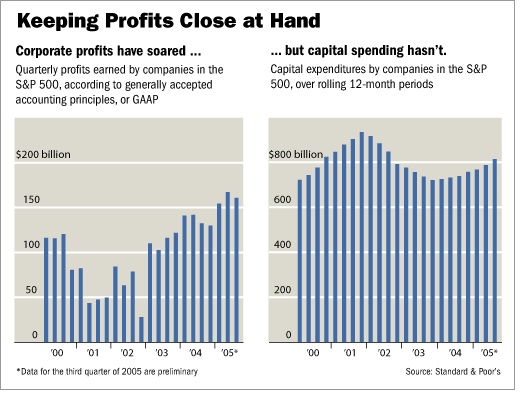Dividends, Buybacks Set New Benchmark for Largess As Corporate Coffers Swell,
Holders Reap the Rewards;
The $1,700-a-Head Bracket
By IAN MCDONALD
Staff Reporter of THE WALL STREET JOURNAL
November 28, 2005; Page A1
Cash-rich American companies are showering a record windfall on their shareholders
-- and in the process stirring some concern about future growth of the U.S.
economy.
This year, the companies in the Standard & Poor's 500-stock index are
on track to pay out more than $500 billion to shareholders in the form of dividends
and share repurchases, or buybacks, according to S&P. That's up more than
30% from last year's record -- and equivalent to nearly $1,700 for every person
in the U.S.
"This is an enormous amount of money being paid, to some degree, in unison," says
Howard Silverblatt, an equity-market analyst at S&P in New York.
The outpouring of cash from corporate coffers in the U.S. is just one aspect
of a world-wide phenomenon. With interest rates low, unprecedented amounts
of capital are sloshing around the globe, in search of better returns. Pension
funds, mutual funds and insurance-company accounts, for example, have some
$46 trillion in assets, up almost a third from five years ago.
 The flood of dividends and share buybacks is a direct result of record U.S.
corporate profits and is welcome news for shareholders, particularly because
dividends are taxed at lower rates and share prices have been flat; since the
beginning of the year, the Dow Jones Industrial Average has risen a paltry
1.4%.
The flood of dividends and share buybacks is a direct result of record U.S.
corporate profits and is welcome news for shareholders, particularly because
dividends are taxed at lower rates and share prices have been flat; since the
beginning of the year, the Dow Jones Industrial Average has risen a paltry
1.4%.
Just this month, 23 companies in the S&P 500 have boosted their dividends,
including General Electric Co. and toy maker Mattel Inc., which also expanded
their share-repurchase plans. For the year as a whole, 275 companies in the
S&P 500 have raised their dividends; only eight have cut them.
In some cases, institutional investors, including mutual funds and activist
hedge funds, are the driving force behind the bigger dividends and buybacks.
This year, for example, New York financier Carl Icahn lobbied for a higher
dividend at Blockbuster Inc. and a more aggressive stock buyback program at
Time Warner Inc., companies in which his Icahn & Co. hedge fund owns big
stakes.
The sharp rise in dividends and buybacks could have major ramifications for
investors, corporations and the economy as a whole, depending on where the
torrent of cash ends up. The payouts could provide a new boost for consumer
spending or could push up stock prices if shareholders reinvest dividends in
stock.
But there could be an economic downside to the cash glut. The fact that companies
have been sitting on so much cash is, in some respects, a vote of no-confidence
in U.S. economic prospects: At least some companies may be signaling they can't
find enough profitable ways to reinvest their earnings, so they are simply
returning it to shareholders.
Through dividends, a company, in effect, distributes part of its profits directly
to shareholders. Share buybacks, in which a company buys some of its own shares
outstanding, can benefit shareholders in other ways: They can boost the company's
share price, and they can also be a smart corporate investment if the company
correctly judges that its stock is undervalued.
 The recent and sharp rise in these payouts marks a significant transformation
in the way companies allocate their profits -- sharing more with investors,
instead of reinvesting their businesses. If the trend persists, it would mark
a return to historic norms in which dividends made up a big part of an investor's
return.
The recent and sharp rise in these payouts marks a significant transformation
in the way companies allocate their profits -- sharing more with investors,
instead of reinvesting their businesses. If the trend persists, it would mark
a return to historic norms in which dividends made up a big part of an investor's
return.
Dividends have been on the rise since the Bush administration succeeded in
cutting the tax rate on them to 15% in 2003, as opposed to taxing dividends
as regular income. But that tax cut is set to expire after 2008 and extensions
have stalled thus far in Congress amid steep budget and trade deficits.
Even after the recent rebound in dividend payments, however, the average S&P
500 stock has a dividend yield of just 1.8% -- about half the historical average.
Currently, U.S. companies are sitting on near-record levels of cash. Among
industrial companies in the S&P 500, a grouping that excludes financial
firms, which are required to hold hefty reserves, the amount totals nearly
$631 billion on the books. That figure represents more than 7% of these companies'
market value -- the highest percentage since 1988.
Some economists call the payouts this year an ominous development that may
be stealing from future economic growth, since they suggest companies are having
trouble spotting new products, projects or services they think will boost their
growth. "These payments keep the economy growing more slowly because that
money isn't flowing into capital spending," says Milton Ezrati, chief
economist at Lord Abbett Funds in Jersey City, N.J. "If businesses are
giving up on innovation, we have problems."
Others could argue, however, that U.S. companies are merely starting to bring
their payouts to shareholders back near historical levels in a mature economy
with more pressure for shareholder-friendly corporate governance in the wake
of accounting scandals.
A big driver of the record profits making these payouts possible isn't a runaway
economic boom, but rather deep corporate cost-cutting in recent years. After
the accounting scandals and economic downturn that followed the end of the
tech bubble, executives pulled in their horns. Instead of shopping for acquisitions,
many companies have refinanced debt to take advantage of lower interest rates
and hacked away at costs that built up during frothier times.
While acquisition activity has ticked up in recent quarters, deep-pocketed
private-equity firms have made many of these purchases, rather than companies
spending from their war chests. As a result, mammoth mergers haven't been as
common as in the heady 1990s.
"Over the past five or so years we've had a bear market, corporate scandals
and a lot of geopolitical uncertainty, so a lot of executives hunkered down," says
Michael Maubossin, chief investment strategist with Legg Mason Capital Management.
Indeed, capital spending by the companies in the S&P 500 has grown only
modestly over the past two years, after two years of declines, according to
S&P.
So when the economy finally got some traction in recent years, companies were
leaner and more profitable. For a record 14 consecutive quarters, companies
in the S&P 500 have reported double-digit profit growth, according to S&P's
Mr. Silverblatt. His firm's projections have the record streak lasting at least
two more quarters.
If profits do remain strong, however, employees and unions may put pressure
on companies to direct more of that money to higher wages and benefits, after
several quarters of modest wage growth and benefit cuts at many firms amid
rising health-care costs.
So far, companies have felt free to spend a big chunk of their profits on
their own stock. This year, nearly 60 companies in the S&P 500 have cut
their number of shares outstanding by at least 4% through repurchases, according
to S&P.
Overall, in the first nine months of this year, S&P 500 companies paid
out $147 billion in dividends and spent $231 billion on share repurchases --
a figure that includes only actual purchases, excluding buybacks not yet completed.
Mr. Silverblatt of S&P expects dividend payouts and share repurchases for
S&P 500 companies to top $500 billion for the full year.
To put that figure in perspective, it could pay off the federal budget deficit
for the just-ended fiscal year with about $180 billion to spare.
And many companies have plenty of money left over after increasing their dividends
and buyback programs. Even after paying out $10 billion in dividends next year
and spending $3 billion on capital expenditures, for instance, GE expects to
have an extra $11 billion in free cash after paying its overhead next year.
"We've tried to accommodate investors who want a dividend, those who
want buybacks and also those who want us to keep growing the company," says
Keith Sherin, GE's chief financial officer.
Although dividends and buybacks are often lumped together, they have considerably
different implications for a company and its investors. A quarterly dividend
check can serve not only as a carrot for investors, but also a check on overspending
for corporate managers. Research has shown that companies that pay dividends
tend to have healthier long-term profits than those that don't.
A share repurchase can be a plus for investors too: If a company buys its
own shares when they are cheap, it can support the stock price and thus boost
investors' returns. Of course, the opposite holds true if the company buys
at a price well above the shares' value.
Share repurchases have many fans on Wall Street, particularly with shares
of big "growth" companies trading at their lowest valuations in years.
For years they had the upper hand over dividends because they were viewed as
more tax efficient. That argument has been sapped a bit by the dividend-tax
cut.
Dividend checks are favored by many investors. A dividend is cash in hand,
after all, whereas the value of a share repurchase depends on whether the company
is buying shares at an attractive price.
"A dividend is better than a buyback for investors," says Patrick
Dorsey, head of stock analysis at Chicago researcher Morningstar Inc. "The
company is saying we're going to give you some of our income each quarter,
and as a result we're going to have to think harder and smarter about what
we do with the rest of that money."
The good news for dividend fans is that it looks like there's ample room for
these checks to grow from here. Today, 385 companies in the S&P 500 pay
dividends, down from a peak of 469 in 1980. And even though billions are going
out the door, dividends only comprise about 32% of payers' profits. Historically,
companies have paid out about 54% of their profits as dividends.
Write to Ian McDonald at ian.mcdonald@wsj.com
 The flood of dividends and share buybacks is a direct result of record U.S.
corporate profits and is welcome news for shareholders, particularly because
dividends are taxed at lower rates and share prices have been flat; since the
beginning of the year, the Dow Jones Industrial Average has risen a paltry
1.4%.
The flood of dividends and share buybacks is a direct result of record U.S.
corporate profits and is welcome news for shareholders, particularly because
dividends are taxed at lower rates and share prices have been flat; since the
beginning of the year, the Dow Jones Industrial Average has risen a paltry
1.4%. The recent and sharp rise in these payouts marks a significant transformation
in the way companies allocate their profits -- sharing more with investors,
instead of reinvesting their businesses. If the trend persists, it would mark
a return to historic norms in which dividends made up a big part of an investor's
return.
The recent and sharp rise in these payouts marks a significant transformation
in the way companies allocate their profits -- sharing more with investors,
instead of reinvesting their businesses. If the trend persists, it would mark
a return to historic norms in which dividends made up a big part of an investor's
return.